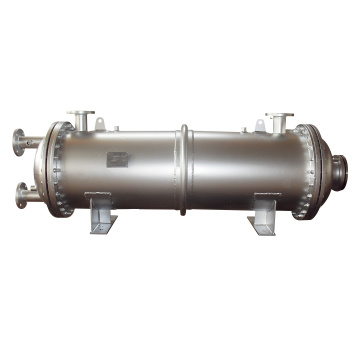
3. Expansion and welding
When the temperature and pressure are high, and under the effects of thermal deformation, thermal shock, thermal corrosion and fluid pressure, the connection between the heat exchange tube and the
Tube Sheet is easily damaged, and it is difficult to ensure the connection strength and tightness by expansion joint or welding requirements. At present, the method of expanding and welding is widely used. The expansion joint and welding structure can effectively damp the damage to the weld caused by the vibration of the tube bundle, effectively eliminate stress corrosion and crevice corrosion, and improve the fatigue resistance of the joint.
Therefore, the service life of the heat exchanger is improved, and it has higher strength and tightness than simple expansion or strength welding. For ordinary heat exchangers, the form of "stick expansion % strength welding" is usually adopted; while the form of "strength expansion % strength sealing welding" is required for heat exchangers with harsh service conditions. Expansion joint plus welding can be divided into two types: first expansion followed by welding and first welding followed by expansion according to the sequence of expansion joint and welding in the process.
(1) The lubricating oil used in the first expansion and then the expansion joint will penetrate into the gap of the joint, and they are very sensitive to welding cracks and pores, which makes the phenomenon of defects during welding more serious. It is difficult to remove the oil stains that have penetrated into the gap, so it is not suitable to adopt the method of mechanical expansion and welding after expansion first. Although the expansion is not pressure-resistant, it can eliminate the gap between the tube and the tube plate hole, so it can effectively damp the vibration of the tube bundle to the welding part of the tube mouth.
However, the conventional manual or mechanically controlled expansion method cannot meet the uniform expansion requirements, and the liquid bag expansion method controlled by the computer to control the expansion pressure can conveniently and uniformly achieve the expansion requirements. During welding, due to the influence of high-temperature molten metal, the gas in the gap is heated and expands rapidly. These high-temperature and high-pressure gases will cause certain damage to the sealing performance of the strength expansion when they leak out.
(2) Expansion after welding For the process of expansion after welding, the primary problem is to control the precision and coordination between the tube and the tube plate hole. When the gap between the tube and the tube hole of the tube sheet is small to a certain value, the expansion process will not damage the quality of the welded joint. However, the ability of the weld joint to withstand shear force is relatively poor, so if the control fails to meet the requirements during strength welding, it may cause over-expansion failure or damage to the welded joint by expansion joints.
During the manufacturing process, there is a large gap between the outer diameter of the heat exchange tube and the tube hole of the tube sheet, and the gap between the outer diameter of each heat exchange tube and the tube hole of the tube sheet is not uniform along the axial direction. When expanding after welding, the centerline of the tube must coincide with the centerline of the tube hole of the tube sheet to ensure the quality of the joint. If the gap is large, due to the high rigidity of the tube, excessive expansion deformation will cause damage to the welded joint. damage, or even desoldering.
4. Glue and expansion
The process of bonding and expansion can help solve the problems of leakage and leakage that often occur at the connection between the heat exchange tube and the tube sheet in the heat exchanger. It is important to choose the adhesive correctly according to the working conditions of the parts to be bonded. . In the process of process implementation, the process parameters should be selected in combination with the structure and size of the heat exchanger, mainly including curing pressure, curing temperature, expansion force, etc., and strictly controlled during the production process. This process is simple, easy and reliable, has been recognized in the actual use of enterprises, and has promotional value.
Conclusion
(1) In the connection method between the heat exchange tube and the tube sheet of the shell-and-tube heat exchanger, it is difficult to guarantee the connection strength and the sealing requirements by conventional welding or expansion joint alone.
(2) The method of expansion joint and welding is conducive to ensuring the connection strength and sealing between the heat exchange tube and the tube sheet, and improving the service life of the heat exchanger.
(3) The method of glue joint and expansion joint is helpful to solve the leakage and seepage problems that occur when the heat exchange tube is connected to the tube sheet, and the process is simple, feasible and reliable.
(4) As a full penetration welding method, the inner hole welding technology has good resistance to crevice corrosion and stress corrosion, anti-vibration fatigue strength, and mechanical properties of welded joints; the internal quality of the weld can be controlled and improved. To ensure the reliability of the weld, it is more suitable for promotion and application in high-end products.




![]() July 14, 2023
July 14, 2023 3. Expansion and welding
3. Expansion and welding